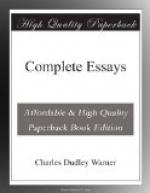The analytic method in fiction is interesting, when used by a master of dissection, but it has this fatal defect in a novel—it destroys illusion. We want to think that the characters in a story are real persons. We cannot do this if we see the author set them up as if they were marionettes, and take them to pieces every few pages, and show their interior structure, and the machinery by which they are moved. Not only is the illusion gone, but the movement of the story, if there is a story, is retarded, till the reader loses all enjoyment in impatience and weariness. You find yourself saying, perhaps, What a very clever fellow the author is! What an ingenious creation this character is! How brightly the author makes his people talk! This is high praise, but by no means the highest, and when we reflect we see how immeasurably inferior, in fiction, the analytic method is to the dramatic. In the dramatic method the characters appear, and show what they are by what they do and say; the reader studies their motives, and a part of his enjoyment is in analyzing them, and his vanity is flattered by the trust reposed in his perspicacity. We realize how unnecessary minute analysis of character and long descriptions are in reading a drama by Shakespeare, in which the characters are so vividly presented to us in action and speech, without the least interference of the author in description, that we regard them as persons with whom we might have real relations, and not as bundles of traits and qualities. True, the conditions of dramatic art and the art of the novel are different, in that the drama can dispense with delineations, for its characters are intended to be presented to the eye; but all the same, a good drama will explain itself without the aid of actors, and there is no doubt that it is the higher art in the novel, when once the characters are introduced, to treat them dramatically, and let them work out their own destiny according to their characters. It is a truism to say that when the reader perceives that the author can compel his characters to do what he pleases all interest in them as real persons is gone. In a novel of mere action and adventure, a lower order of fiction, where all the interest centres in the unraveling of a plot, of course this does not so much matter.
Not long ago, in Edinburgh, I amused myself in looking up some of the localities made famous in Scott’s romances, which are as real in the mind as any historical places. Afterwards I read “The Heart of Midlothian.” I was surprised to find that, as a work of art, it was inferior to my recollection of it. Its style is open to the charge of prolixity, and even of slovenliness in some parts; and it does not move on with increasing momentum and concentration to a climax, as many of Scott’s novels do; the story drags along in the disposition of one character after another. Yet, when I had finished the book and put it away, a singular thing happened. It




